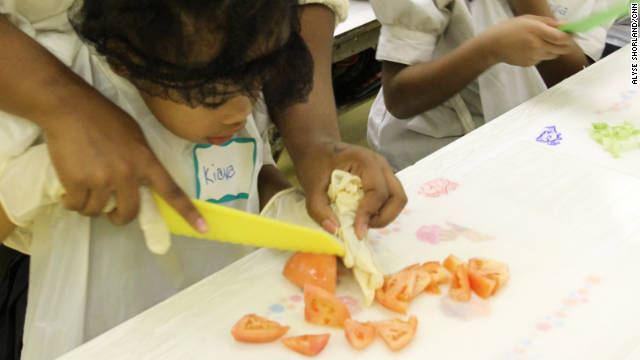
Students gathered as the chef sliced
tomatoes with a plastic knife in a Brooklyn public school cafeteria. Their eyes
followed as she held up a slender green cylinder before the crowd of parents
and kids in plastic aprons and hairnets.
"What's that?" kids shouted.
"It's a scallion. But don't eat
it now," warned Leigh Armstrong, a culinary student and volunteer chef.
"It doesn't taste like celery."
Armstrong was helping at Cooking
Matters, a free, six-week class that teaches parents and kids how to shop for and
prepare healthy, inexpensive meals. The program launched 20 years ago through
the nonprofit Share our Strength, and it now serves more than 11,000 families
across the country.
Most participants use or have used
food stamps, free or reduced-price school lunches or food pantries to cover
their nutritional needs, and almost all are still looking for ways to stretch a
few ingredients into meals.
The number of families that struggle
to get enough food has increased in recent years.
The U.S. Department of Agriculture
reported that in 2010, 14.5% of households in the United States -- about 17.2
million -- lacked the resources to provide enough food for everybody. Among
those, about 6.4 million households saw normal eating patterns disrupted or
reduced because there wasn't enough food.
Food insecurity -- uncertainty about
where the next meal will come from -- is particularly hard on one group:
children.
It's a time of record need, a time
when you're seeing people from all walks of life needing to turn to assistance
to meet their food needs.
Paula Thornton-Greear, Feeding America
spokeswoman
The nonprofit Feeding America, a
network of more than 200 food banks around the United States, reports one in
five children are at risk of hunger. For children in African-American or Latino
households, it's closer to one in three.
They're likely to have trouble
focusing in school. They might experience illness or poor health as a result.
They're also likely to struggle with stress at home or in class. While many are
eligible for free or reduced-price food at school, those programs don't provide
food at night, on weekends or during breaks from school.
Hunger is still a more frequent
problem for homes headed by single parents and for homes below the federal
poverty line, the USDA reports, but it has also crept into homes that have
never experienced it before.
"It's invasive and real,"
said Paula Thornton-Greear, a Feeding America spokeswoman. "It's a time of
record need, a time when you're seeing people from all walks of life needing to
turn to assistance to meet their food needs."
For adults, the most important step
might be talking about it, Thornton-Greear said -- reaching out to friends and
family who can help and learning what government and nonprofit food programs
are available.
"At some point, we're all in need
of something," she said. "It's reflective of a society experiencing a
huge downturn. It's not reflective on one individual."
For kids, it might mean getting adults
more engaged in teaching nutrition and stopping hunger before it starts.
On TV, a new "Sesame Street"
puppet, Lily, is talking about food insecurity from the perspective of a
7-year-old who doesn't always have enough to eat.
CNN Hero: Bruno Serato
In Orange County, California, chef and
restaurateur Bruno Serato feeds pasta to about 300 children every night.
Serato, one of the Top 10 CNN Heroes
of 2011, began cooking for kids when his mother visited from Italy and saw a
child eating potato chips for dinner. The boy, like dozens of others near his
restaurant in Anaheim, lived in a motel, where his family had limited access to
food and cooking space.
"'Bruno, you must feed them
pasta,'" he recalled her saying. Serato continued the nightly pasta feast
throughout the recession, even as his restaurant struggled.
"They're customers," he told
CNN earlier this year. "My favorite customers."
And back in Brooklyn, it means
teaching parents to shop and cook with kids in tow. The Cooking Matters
curriculum includes taking families to grocery stores and then getting them
into kitchens at schools, community centers or even housing units.
Today's menu: breakfast burritos with
eggs, cheese and homemade salsa. The cost: less than $2 a serving.
At Saprina Gressman's first Cooking
Matters class this month, the 25-year-old mother of three said her kids first
told her about the class.
"I'm hoping to learn a lot,"
she said, as she helped her 4-year-old daughter, Kiara, cut a tomato to make
salsa. "I'm hoping to learn to cook with my children, because you need
patience."
While parents will usually be the ones
to budget, buy and cook food, getting kids excited about preparing and eating
homemade meals can keep everyone engaged in healthier choices and smart
shopping.
Aliyah Rowe, the Cooking Matters
program coordinator for City Harvest in New York, said some members of the
class rely on food stamps, but it's designed for anyone with food insecurity --
people who recently lost jobs and have to rethink their food budgets, or
families that occasionally seek assistance from food banks.
It also gets parents and kids spending
time together and talking about the food the fuels them.
"I remember baking with my
grandmother, but that doesn't happen anymore," Rowe said. "The
reality is parents are busy; you have some that work two jobs. But the kids
come here and they are so excited, and they go home excited. And that inspires
parents to cook with their children."
By Alyse Shorland and Jamie Gumbrecht, CNN
No comments:
Post a Comment